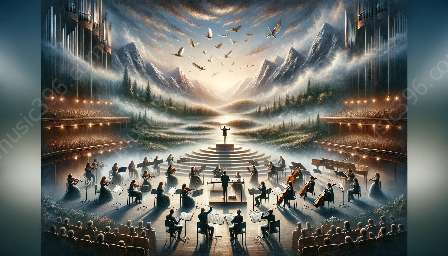Music iconography blends technology and production to create powerful visual representations of the music and its history. From album cover art to music videos, music iconography holds a significant place in the music industry. This article explores the impact of technology on music iconography, its references in music history, and how it shapes the way we perceive music and iconic musicians.
The Intersection of Technology and Music Iconography
Technology has played a pivotal role in shaping the visual representation of music. The use of graphic design software, digital imaging, and multimedia tools has enabled artists and designers to experiment with various visual elements to capture the essence of the music in a visually compelling manner. The advent of digital platforms and social media has further elevated the visibility and reach of music iconography, allowing artists to connect with their audiences in a more immersive manner.
Production Techniques and Innovations
Production techniques are at the heart of music iconography. The process of designing album covers, creating music videos, and developing visual branding involves the use of modern production tools and techniques. From photography and videography to animation and digital art, the production of music iconography encompasses a wide array of creative processes that are constantly evolving with technological advancements.
Evolution of Music Iconography in the Digital Age
With the rise of digital platforms and streaming services, music iconography has undergone a transformative evolution. The consumption of music has become increasingly visual, and artists are leveraging technology to create immersive and interactive visual experiences for their fans. Virtual and augmented reality, interactive websites, and multimedia installations have become integral components of modern music iconography, allowing artists to convey their artistic vision in innovative and captivating ways.
References in Music History
Music iconography is deeply rooted in music history, with iconic album covers, music videos, and visual motifs serving as important references in the evolution of popular music. From the iconic cover art of The Beatles' Abbey Road to Michael Jackson's groundbreaking music videos, these visual representations have become synonymous with the identity of the artists and their impact on music history. By delving into the references and influences of music iconography, we can gain a deeper understanding of its significance in the broader context of music culture.
Impact on the Music Industry
The impact of music iconography on the music industry cannot be understated. Visual branding and imagery play a crucial role in shaping the identity of artists and influencing audience perceptions. The visual storytelling inherent in music iconography contributes to the overall narrative of an artist's work, creating a multi-sensory experience that resonates with fans on a deeper level. Furthermore, the commercial viability of music iconography is evident in the popularity of merchandise, limited edition releases, and collectible items that feature iconic visual elements.
Embracing Technology for Future Innovations
As technology continues to advance, the future of music iconography holds endless possibilities. From immersive virtual reality experiences to interactive visual narratives, artists and designers are poised to harness the power of technology to push the boundaries of music iconography further. The fusion of music, technology, and visual storytelling will continue to redefine the way we perceive and engage with music, creating a dynamic landscape for innovation and creativity.








































